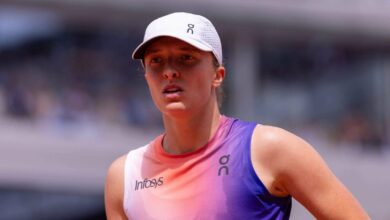‘Just do your best’: Exhaustion is part of the game for the Women’s Open field

ST. ANDREWS, Scotland — Stacy Lewis is back at the head table of the media room, answering a late-night question from someone who was too shy to shout above the gusts of wind during the press conference.
Her five-year-old daughter Chesnee wants to know if she can get a swimming pool – “a big pool” – if her mother wins here, like she did in 2013.
“I think I can help you, girl,” Lewis says.
Eleven years have passed since the Texas native birdied the final two holes to win the Women’s Open by two strokes. The second shot in 17 remains the best of her career, so much so that the 5-iron is the only club she has kept in front of her office.
But over time, as motherhood has pushed golf off her priority list and given her less tunnel vision, the demands of the LPGA Tour have become even more all-consuming.
This year’s tour kicked off with two events in Florida and ends with three more in the Sunshine State. The intervening 10 months? A map of zigzags across the United States, Canada, Europe and Asia that wouldn’t look out of place in Chesnee’s school notebook.
This week’s Open is the fifth major in as many months, excluding the Olympic Games at Le Golf National, France, earlier this month. St. Andrews closes out the majors season, but with the Solheim Cup in September and another Pacific leg this fall involving China, South Korea, Malaysia, Japan and Hawaii in the space of just 35 days, the schedule is jam-packed and shows no signs of ending anytime soon.
During this press conference we will only ask the most important questions!!!
Chesnee asked mom @Stacy_Lewis if she could get a pool 🥰😂 photo.twitter.com/bhqgapR1Yz
— LPGA (@LPGA) August 21, 2024
During the combined 33 LPGA Tour stops and majors this year, there will be more than 215 hours of pure air time. The total miles add up to more than three trips around the world.
This isn’t a new problem — last year’s schedule included a record 18 trips with more than 2,000 miles between tour stops. This season, there were the trips to China and intracontinental visits to Thailand and Malaysia; the criss-crossing from west coast Los Angeles to east coast New Jersey in May; the seesaw-sawing from Michigan to the PGA Championship in Washington State and back to Michigan in June, two six-hour flights with just four days of rest in between.
Eight and a half months into the season, with 40-45 mph winds forecast for Thursday and many players unable to play the Scottish Open to reacquaint themselves with links golf, can a player be expected to be at the peak of his powers? “Probably not, no,” said Lewis, who will captain Team USA for the Solheim Cup in Virginia next month. “Those who have played in the Olympics, you talk to most of them and it’s just so emotionally taxing that week. So no, our schedule, especially the Olympic years, is really, really tough.
“There’s been a lot of talk about schedules lately, but at the same time, I’ve been doing this for 15 or 16 years. You learn how to deal with it, and you learn how to be ready in those moments and just do your best.”

GALLING DEEPER
The Women’s Open is at St. Andrews. The Old Course is ready to challenge the field
Since 2009, prize money at the Women’s Open has risen from $2.2 million to $9 million, a 409 percent increase. That’s a threefold increase since AIG began sponsoring the tournament in 2020.
Lewis described the improvement in infrastructure and facilities at the Women’s Open as “night and day” compared to 2013, but believes their hands are tied when it comes to finding ways to ease the gruelling schedule.
“I think that’s the ideal, but it’s really a question of when do sponsors want to play and when do we get the golf courses?” she said.
“We don’t have the luxury of the PGA Tour saying, ‘We’ll give you a certain amount of money and we’ll play this week.’ We don’t have the money to just throw around.
“We’re a little bit at the mercy of sponsors. We’re at the mercy of golf courses and that’s the nature of where we are. Would we like to be better? Yes, absolutely. I think our team behind the scenes is working like crazy, but we’re a global tour and I want to compete against the best players every week.
“To do that, we have to play in Thailand, because we have players from Thailand. We’re going to play in Korea, because we have players from Korea. I think that’s just the nature of it. It’s more that you have to get into your head, for me, that this is a worldwide tour. You say you’re going to play on the LPGA Tour, that’s what you signed up for.”
World number one Nelly Korda won six tournaments in seven starts between January and May, including the Chevron Championship, and has won more than $3 million in prize money this year.
That gives her the luxury of skipping the entire Asia swing, a seven-week break earlier this year that broke up her winning streak. But even the two-time major winner was forced to withdraw from the JM Eagle LA Championship in April, citing exhaustion.

Nelly Korda has taken a few weeks off regularly this season, a luxury not all LPGA pros can afford. (Michael Reaves/Getty Images)
Lexi Thompson opened the conversation about the mental and physical demands of the LPGA Tour in May when she announced she would retire at the end of the season, at age 29.
She spoke about how “lonely” and all-consuming life on tour has been since she qualified for her first US Open at age 12, but she believes there are ways to lighten the load.
“The schedule is definitely there,” Thompson said. “I think all the traveling pays off. I think the flow of the schedule could be better. Some events could be back-to-back that are close together. We travel a lot overseas, but it’s a worldwide tour, so that’s part of it, and we’re very fortunate with the sponsors that we have outside of the country.
“There’s a little bit less pressure on my shoulders after the announcement, because it’s been on my mind for a couple of years. So it’s something that’s inside me and nobody really knew about it or what was going to happen.”
Catriona Matthew won her only major at the Open in 2009, winning at Royal Lytham & St Annes just 11 weeks after giving birth. Now 54, Matthew is making her final appearance at her home tournament and doesn’t know how she managed to tour with her two children in the years since.
To continue to strive for a new major in a field as large as Lewis’s, he says, requires tremendous resilience.
Lydia Ko hopes to end an eight-and-a-half-year hiatus this week, but the Australian is on a roll after winning gold in Paris. She is the 35th woman to be inducted into the LPGA Hall of Fame.
She remains the youngest woman to ever win on the LPGA Tour, having triumphed at age 15. But 12 years later, there was an immediate dose of realism about how long she was willing to endure the back pain she experiences in the mornings — and whether she could push forward her planned retirement at age 30.
“It can be scary in a way because I’ve been playing golf since I was five,” Ko said.
“This is my life, whether I like it or not, and golf has given me so much to be thankful for, both on and off the golf course.
“As grateful as we are to be able to do what we love and compete at a high level, I think there’s another side to it that you have to consider. As someone who is maybe closer to that point in my career than when I was a rookie, you realize all of those things and you respect the player for the decision that they made.”
There are players who are still determined to join the majors club, most notably England’s Charley Hull. His attitude towards a recent shoulder injury reflects the mentality needed to handle this hectic schedule.
“My shoulder has gotten a little stiff, so I’m having acupuncture done on it every other day because when it’s cold it can act up a little bit,” she said.
“I also have degenerative arthritis in it. So when it gets cold, it gets a little stiff. I just try to keep it warm.
“Other than that, I’m healthy and ready to go.”
(Top photo: Luke Walker/Getty Images)




